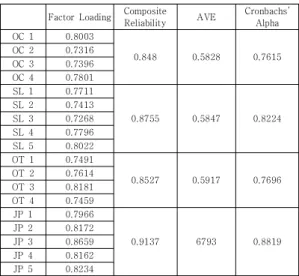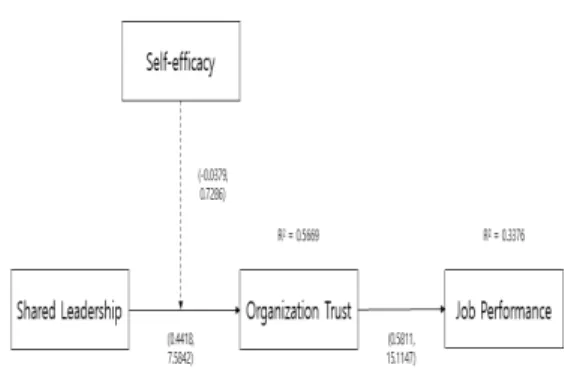A Study on Factors Relevant to Effects of Shared Leadership, Organizational Trust and Job Performance
Jae-Boong Kim
Professor, Department of Business Administration, Korea National University of Transportation
공유리더십, 조직신뢰, 직무성과의 영향 요인에 관한 연구
김재붕
한국교통대학교 경영학과 교수
Abstract The change to the horizontal structure of the modern corporate management environment requires joint efforts and cooperation to share responsibility and purpose and to increase positive mutual influence in order to achieve the corporate goal beyond the individual capacity of the organizational members. In order to achieve the purpose of the organization, the organizational structure in which various members share information and aim at collective leadership is more effective than the structure concentrated on one individual (leader). This study was to examine the effectiveness of shared leadership, and to investigate the causal relationship and effect of shared leadership, organizational trust, and job performance. As a result of the analysis, shared leadership had a positive effect on organizational trust, and organizational trust had a positive effect on job performance. This means that high trust in organization has a positive effect on performance.This study is meaningful in that it examines the difference between shared leadership and existing leadership types that have not been studied yet.
Key Words : Shared Leadership, Organizational Trust, Job Performance, Leadership, PLS
요 약 현대 기업경영 환경의 수평적 구조화로의 변화는 조직구성원 개개인의 역량을 넘어, 기업의 목표를 이루기 위해 팀이나 조직 전체가 책임과 목적을 공유하고, 긍정적인 상호영향력을 높이기 위한 공동의 노력과 협력을 요구하고 있으며, 조직의 목적을 달성하기 위해 한 개인(리더)에게 집중화된 구조보다는 여러 구성원들이 정보를 공유하고 집합 적인 리더십을 지향하는 조직 구조가 더 효과적이다. 이에 본 연구는 공유리더십의 효과성에 대해 살펴보고자 하였으 며, 공유리더십과 조직신뢰 그리고 직무성과에 대한 인과관계 및 영향에 대해 조사하였다. 분석결과, 공유리더십은 조 직신뢰에 정의 영향을 미치는 것으로 나타났으며, 조직신뢰는 직무성과에 정의 영향을 미치는 것으로 나타났다. 이는 조직에 대한 신뢰가 높으면 성과에도 긍정적인 영향을 미친다는 것을 의미한다. 본 연구는 아직 연구가 많이 되지 않은 공유리더십과 기존의 리더십 유형들과의 차별성을 살펴보고자 한 것에 의의가 있다.
주제어 : 공유리더십, 조직신뢰, 직무성과, 리더십, PLS
*This was supported by Korea National University of Transportation in 2018.
*Corresponding Author : Jae-Boong Kim(hgjbkim@naver.com) Received June 17, 2019
Accepted July 20, 2019
Revised July 2, 2019
Published July 28, 2019
1. Introduction
Organizational competitiveness comes from organizational members in the fast-paced business environment. Organizational members’
competitiveness is their adjustment to the ever-changing environment so as to create performance. Unprecedentedly increasing uncertainties in business environment force organizations to stress their members’expertise, personality and creativity[1].
The rapid advancement of ICT has led us to the age of Industry 4.0, when AI, intelligence and other technologies are causing a chain of changes. The rapidly changing circumstances underscore the roles of a leader in coping with the endless challenges of the time.
The ever more profound changes and uncertainties in business environment add to the need for autonomous performance of jobs in a bid to efficiently run an organization and flexibly respond to diversifying complex circumstances[2].
In the same vein, a new type of leadership is drawing attention as a means of empowering organizational members to autonomously fulfil their jobs, while facilitating organizational efficiency.
Leaders play pivotal roles in any organization on the grounds that they clarify organizational goals and orientation via missions and visions to overcome internal and external adversities and increase their organizational performance and that they influence organizational members so that they can achieve the goals[3].
Leaders and leadership have been well-documented. Yet, most previous studies were primarily concerned with the conventional vertical leadership. As the typology of leadership, transformational, transactional, charismatic, authentic and issue leaderships have been defined and explored.
The horizontal leadership was mentioned in earlier research on leadership. It was suggested that when organizational members autonomously
influence one another towards common goals, members’ shared leadership serves as an important source for maximizing the organizational effectiveness[4].
It is vital under the current uncertain condition to capitalize on unprecedented leadership strategies for any business or organizational operation.
Shared leadership is being magnified as an emerging type of leadership. Shared leadership refers to imposing leadership responsibilities on organizational members, and having more than one unofficial leaders lead an organization together with one official leader. Shared leadership affects the organizational trust, and ultimately the job performance. Thus, this study sets the shared leadership as the independent variable, the job performance as the dependent variable, the organizational trust as the mediator, and the self-efficacy as the moderator.
2. Theoretical Background
2.1 Shared leadership
Shared leadership refers to the behavior of sharing the leadership among group or organizational members[5]. The phenomenon of shared leadership is an important concept in leadership studies, and worth further exploring.
Shared leadership engages attention as a new type of leadership enabling members to improve competencies while influencing one another.
Researchers have continuously classified and measured the patterns common to the shared leadership.
Classified the shared leadership into directive
shared leadership, transactional shared leadership,
transformational shared leadership and delegating
shared leadership. Illuminated the shared leadership
was more effective than the conventional vertical
leadership. Also, Pearce & Sims(2002) illuminated
the shared leadership was more effective than
the conventional vertical leadership[6].
2.2 Organization trust
Zucker(1986) argues trust is a series of institutional expectations shared by all participants in transactions[7] and exchanges. Mishra(1996) defines trust as a behavior of willingly exposing one’s vulnerability to another person based on the belief that the latter is so competent, open-minded, caring and trustworthy that he/she can rely on the person for his/her welfare[8].
Levering(2000) classifies the components of organizational trust into trust in the relationship between staff, supervisors and management, pride which involves the relationship between staff and their work, and fun which involves the relationship with colleagues, and articulates trust is a multi-dimensional concept germane to such factors as authenticity, respect for others and justice[9].
Eisenberg et al.(1986) defines organizational trust as organizational members’ perception of the value given to their contribution and the care about their welfare[10].
2.3 Job performance
Blumberg & Pringle(1982) defined job performance as the gains from the outcomes of organizational members’ attributes, job efforts and organizational support[11]. Job performance provides the information about decisions on staff rewards and training in overall organizational operation and members’ performance improvement and termination[12].
Pincus(1986) stated job performance is closely related to efficiency, goal achievement and supervisor appraisal[13]. McCormick & Ilgen(1980) set such measures of job performance as productivity, error rates, complaints and accuracy[14].
Martin, Price& Mueller(1981) proposed such measures as goal achievement, problem-solving skills, specialized knowledge about jobs, work connection with juniors and colleagues, and quantitative work processing skills[15].
Stumpf & Hartman(1985) defined job performance as organizational members’
perception of their job performance against the performance criteria required in the job and their perception of doing the best for their jobs[16]. Packard(1989) said job performance could be represented as job fulfillment or work performance[17].
2.4 Self-efficacy
Bandura(1997) suggested the self-efficacy theory as a cognitive viewpoint for explaining and predicting a person’s behavioral change[18].
Self-efficacy directly influences one’s own behavior, and such variables as goal aspiration, expectation of rewards for performance results, perception of difficulties and opportunities and decision making.
Fisher(1984) argued a person with high self-efficacy tends towards self-directed attribution, questions his capacity for work first and loses self-confidence[19], when he fails to meet any expected efforts for achieving goals and go through job burnout, whereas one with low self-efficacy tends towards situational attribution for difficulties or failures, preserving his self-esteem[20]. High self-efficacy will have positive effects on organizational trust and job performance.
3. Research Method
Fig. 1. Research Model
This study sets the shared leadership as the independent variable, and the job performance as the dependent variable to determine the mediating and moderating effects of the organizational trust and self-efficacy, respectively. Fig. 1 shows the model developed to that end.
Pearce & Sims(2002) reported shared leadership is effective for resolving organizational conflicts and building some organizational harmony. Trust among organizational members enhances the intrinsic value found in constructive interpersonal relationships in workplace.
Researchers demonstrated trust is a strong predictor of competitive advantages[21], improved organizational learning[22], and improved financial performance[23]. Thus, shared leadership will have positive effects on the development of organizational trust as hypothesized below.
H1. Shared leadership will have positive effects on organizational trust.
As a rule, organizational satisfaction leads to organizational commitment, which ultimately helps organizational members to concentrate on their work. As a result, job performance improves.
Kim et al. (2013) argued organizational social responsibilities[24] and relevant activities increased organizational images and organizational trust.
Kim(2008) investigated the direct effects of staff’s trust in supervisors on organizational performance[25]. Ji & Jang (2008) determined the relationship between staff relationship factors, trust and performance[26].
Hence, this study hypothesizes the relationship between organizational trust and job performance as follows based on previous findings.
H2. Organizational trust will have positive effects on job performance.
A leader is an important link in forming individual and collective behaviors and connecting those with organizational performance[27], which facilitates the interactions, encourages cooperative activities among organizational
members, and helps effectively achieve goals.
Particularly, self-efficacy seems to moderate between shared leadership and organizational trust, which underlies the following hypothesis.
H3. Self-efficacy will moderate the relationship between shared leadership and organizational trust.
4. Results
The survey surveyed Korean companies from April 2, 2018 to April 20, 2008. A total of 116 copies were used in the survey analysis, excluding the unfaithful responses. In this study, a survey was conducted on Korean manufacturers.
Also, this study used a structural equation model widely used in social sciences and the PLS tool for analysis.
In PLS, the composite reliability, convergent validity, and discriminant validity must be verified for a model’s goodness-of-fit. This study used PLS for analysis and verified those validities[28,29].
Factor Loading Composite
Reliability AVE Cronbachs’
Alpha OC 1 0.8003
0.848 0.5828 0.7615
OC 2 0.7316 OC 3 0.7396 OC 4 0.7801 SL 1 0.7711
0.8755 0.5847 0.8224
SL 2 0.7413 SL 3 0.7268 SL 4 0.7796 SL 5 0.8022 OT 1 0.7491
0.8527 0.5917 0.7696
OT 2 0.7614 OT 3 0.8181 OT 4 0.7459 JP 1 0.7966
0.9137 6793 0.8819
JP 2 0.8172 JP 3 0.8659 JP 4 0.8162 JP 5 0.8234
Table 1. Discriminant Validity Analysis
First, the composite reliability was above 0.7.
The factor loading was above 0.7. The AVE was
above 0.5, supporting the convergent validity as shows that Table 1.
Composite Reliability was higher than the reference value of 0.7 and AVE was also higher than the reference value. In addition, Cronbach' Alpha also came above 0.7 and met all the criteria. This shows that this research model is appropriate.
OC JP OT SL
OC 0.7634
JP 0.4872 0.8242
OT 0.5811 0.6739 0.7692
SL 0.7222 0.6499 0.6932 0.7647
Table 2. Correlation between Latent Variable
For the discriminant validity, the lowest value on the diagonal line should exceed the largest value below the line. The discriminant validity was verified[30-32]. Fig. 2 shows that correlation betwen Latent Variable also met the criteria.
Path Coefficient t-value Results
H1 SL→OT 0.4418 7.5842*** Accepted
H2 OT→JP 0.5811 15.1147*** Accepted
H3 SE * SL→ OT -0.0379 0.7286 Rejected

